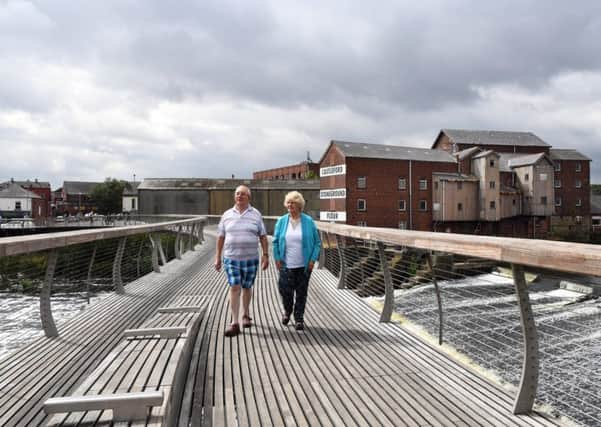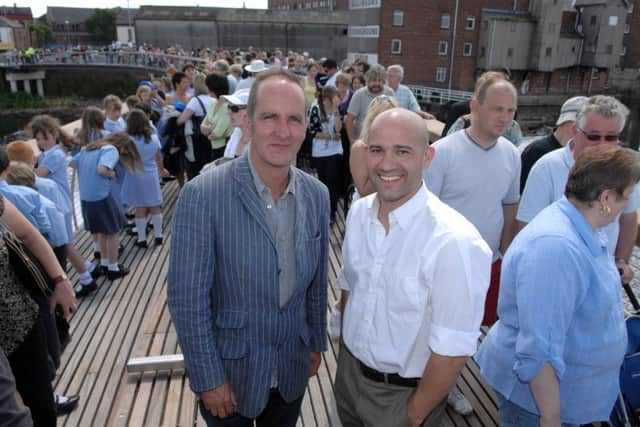The Big Town Plan revisited - ten years on, how has The Castleford Project impacted on the town?


The journey over Castleford footbridge is only a short one, a 130 metre route between the town centre at one side of the River Aire and homes and businesses on what is locally known as ‘Duck Island’ at the other.
But it is a permanent reminder of a much longer journey and one that is still ongoing today - the regeneration of the former mining town.
Advertisement
Hide AdAdvertisement
Hide AdThe opening of the bridge a decade ago marked the end of a five year community improvement scheme, which it was hoped would be a catalyst for change.


But while the ripples of The Castleford Project, which was one of the world’s first televised regeneration schemes, have inspired a redevelopment revolution among some members of the community, others still speak of a failing town in need of revival, and it could be up to 20 years before a town masterplan devised by Wakefield Council comes to full fruition to “transform” the area.
“I think The Castleford Project kick-started things and made people feel that Castleford was on the map,” says deputy council leader and Castleford councillor Denise Jeffery.
She claims the scheme captured the interest of residents and “empowered” them to take action to support their town.
Advertisement
Hide AdAdvertisement
Hide Ad“In Castleford there are so many community groups now, it is unbelievable,” says coun Jeffery, who is also a cabinet member for economic growth and regeneration.
“The bridge has definitely had an impact,” agrees Rod Rayner, a local resident who worked on the scheme. As well as being used by around 200 people each day, including walkers and cyclists, he says the £4.8m bridge provides a safe route across the river and has attracted admirers from outside the town, bringing people into the area. “There’s lots of people that come and have a look.”
The Castleford Project was born back in 2003 when Castleford was chosen to be the subject of a Channel 4 restoration scheme.
In the five years that followed, the broadcaster and Grand Designs presenter Kevin McCloud collaborated with residents, Wakefield Council, architects and regional and national funding agencies on several community-led improvement projects totalling £11m.
Advertisement
Hide AdAdvertisement
Hide AdThese included the construction of the Millennium Bridge, as it is officially known, designed by Renato Benedetti, a new town square and a play forest.
The “urban regeneration experiment”, as it was deemed, was captured on camera and a four-part series charting the town’s makeover - Kevin McCloud and the Big Town Plan - aired in August 2008, just after the project’s completion.
“In theory, this experiment might encourage big investment from outside,” Kevin explains in the first episode.
“It could make Castleford a thriving town where people want to spend the money they earn, somewhere they want to stay and bring up their families. If it all works it will give this town a future. It will show other towns what’s possible. But if it fails, Castleford will just wither away.”
Advertisement
Hide AdAdvertisement
Hide AdIt is fair to say the economic climate was not onside for further investment; the project came to an end at the same time as the 2008 financial crash and recession. In the words of Coun Jeffery: “We started off regenerating Castleford and the rest of the Five Towns but because of austerity, we weren’t in a position to do it.”
Castleford, Pontefract and Normanton MP Yvette Cooper says years of austerity since the bridge opened has “made things much harder”.
“Like many other towns across the country we’ve had less job growth than cities and more services hit by cuts, we’ve had pressure on town centre shops and cuts to policing affecting anti-social behaviour,” she says.
Several residents speak now of a “declining” town, with a problem with drugs and alcohol. While Coun Jeffery says police are cracking down on the issue, she admits it is “not easy” to resolve.
Advertisement
Hide AdAdvertisement
Hide Ad“It’s sad to see our lovely town going downhill fast,” says resident Claire Fleming. “The town is like a no go area as it is full of undesirables, the nightlife is a thing of the past.”
“It has been a gradual decline but a steep drop in the last couple of years,” fellow resident Lee Ingram says. “All we seem to have generated in the last ten years is closed business in the town centre, virtually no nightlife” and more people drinking and taking drugs, with “less police presence”.
“I think [Channel 4] would be disappointed with the town centre,” says Gary Webb, who wants to see more investment. “It has not moved on, it looks depressing and tired.”
According to Alison Drake, chairman of the Castleford Heritage Trust, improvements in the past decade have been driven by members of the community.
Advertisement
Hide AdAdvertisement
Hide AdIn 2013, the charity purchased and moved into waterfront venue Queen’s Mill and with the support of grants and a team of volunteers, has made progress on regenerating the town’s riverside.
“We thought, as a community, we can start to do the work of developing the riverside, uniting the town centre with the river, which was the vision right from the start,” says Mrs Drake, a community champion during The Castleford Project.
Community activities run from the mill, which also has an arts and exhibition space and refurbished rooms for businesses.
The group has worked to get the site milling again so members can produce and sell flour to support their work.
Advertisement
Hide AdAdvertisement
Hide AdA newly-revamped tea room opened just weeks ago, a boat house is under construction and plans are also being drawn up to create a brewery, bar and bistro in a neighbouring property.
“The impact [of The Castleford Project] was to make the community realise that if they got together and worked together that can make things happen,” Mrs Drake, who lives in nearby Glasshoughton says.
“And that is what it did. It made the community see that they could take the initiative, have their say and make things work, and that is what we have done, buying that huge site on the riverside and working very hard to make it successful.”
“There are neglected areas of the town,” the 67-year-old admits. “The recession hit and we have had austerity for ten years. Castleford has suffered from that.
Advertisement
Hide AdAdvertisement
Hide Ad“But actually, we are surviving well...There’s work happening, it is being done by local Castleford folk and at the rate that we can go with the money available.” Their efforts in the face of adversity have not gone unnoticed by Ms Cooper. It has been, she says, “community spirit rather than the gaze of the TV cameras that has been the most important thing in making the bridge and Queen’s Mill successful and keeping the riverside regeneration going”.
A new chapter for Castleford’s regeneration is now in the pipeline.
Earlier this year, the council unveiled an Aire River Growth Corridor Masterplan, which could see £750m of private investment for thousands of new homes, business and retail space alongside the river over the next 15 to 20 years.
Asked why the plan had not previously been developed, Coun Jeffery said Wakefield Council has “many different towns to look after” and had to prioritise.
Advertisement
Hide AdAdvertisement
Hide Ad“We realise we need to protect our smaller towns and really get behind them and that’s what we are doing”, she says.
A protection order has been put in place in Castleford to tackle street drinking and urinating and defecating in alleyways.